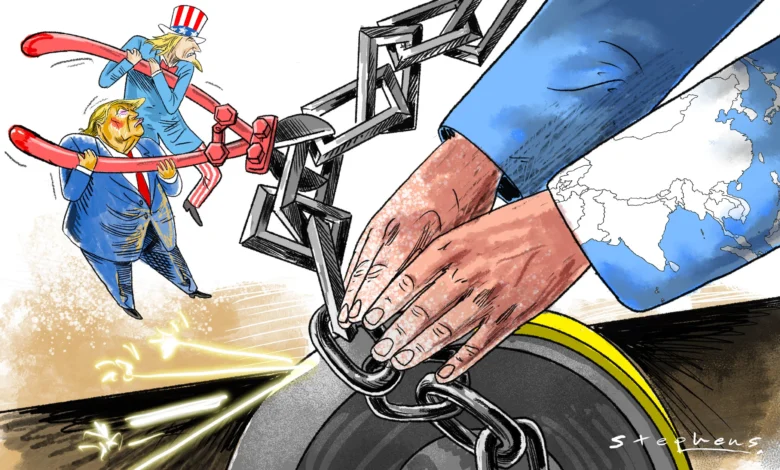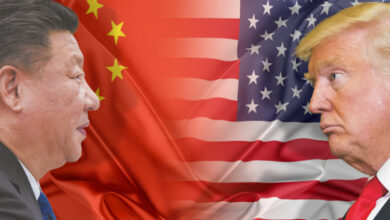China, Tariffs And Trump’s 145% China Levy In The Spotlight. Wall Street Lowers China’s Growth Forecasts, Is The World Ready For Round Two Of The US-China Trade War?

Let us talk tariffs first, President Donald Trump’s latest round of tariffs could soon make everyday items like clothing, smartphones, and furniture significantly more expensive, potentially drawing the curtain on nearly 25 years of affordable consumer goods in the U.S.
The administration argues that these import taxes are aimed at reshoring manufacturing and boosting high-wage employment. However, it’s a long-term bet with uncertain payoffs, especially considering the dominance of automation in modern production and the complexities of rebuilding domestic supply chains.
Despite a temporary pause announced on Wednesday (delaying steep tariffs on about 60 countries for 90 days) overall U.S. tariff levels remain far above what they were just a few months ago.
Currently, a general 10% levy applies to all imports. But imports from China, the U.S.’s third-largest trading partner, now face a staggering 145% duty. Additionally, steel, aluminum, vehicles, and about half of all goods from Canada and Mexico are subject to 25% tariffs.
As a result, the average American tariff has climbed from under 3% before Trump first took office to about 20% now, levels not seen since the 1940s. If sustained, such rates could mark a reversal of decades of globalization that had helped keep prices low for U.S. consumers.
Meanwhile, Wall Street is growing uneasy, over China.
Goldman Sachs on Thursday lowered its forecast for China’s GDP growth to 4.0% for 2025, down from 4.5%, citing the sharp escalation in trade tensions. In under a week, U.S. tariffs on Chinese goods more than doubled, and Beijing has responded with retaliatory duties and new restrictions on American firms.
According to Goldman, the spike in effective U.S. tariffs, from 11% to 125% since Trump’s return to office, could reduce China’s GDP by 2.2 percentage points next year. While China is expected to ramp up policy support to cushion the blow, those efforts may fall short of fully mitigating the economic drag.
Citi also revised its China growth outlook to 4.2%, trimming it by 0.5 percentage points, pointing to limited prospects for diplomatic resolution after the latest flare-up. Natixis followed suit, cutting its projection from 4.7% to 4.2%.
Though Morgan Stanley hasn’t yet adjusted its forecasts, it warned this week of rising downside risks to its current 4.5% prediction.
Earlier this year, China had set a 2025 growth goal of “around 5%,” but officials acknowledged the difficulty of hitting that mark in today’s volatile environment. “The main issue is that uncertainty for the economy is rising,” said Hao Zhou, chief economist at Guotai Junan International, noting a sharp decline in clarity about the path ahead, especially with more U.S. tariffs potentially on the horizon.
Adding to the pressure, Trump has announced an additional 50% tariff on Chinese imports starting Wednesday. This move comes after Beijing raised duties on all U.S. goods by 34%. With earlier rounds of 10% hikes already implemented in 2025, total U.S. tariffs on Chinese imports this year have reached an eye-watering 104%.
Diminishing Impact of New Tariffs
According to a report by Goldman Sachs on Tuesday, while an initial 50% hike in tariffs could shave 1.5 percentage points off China’s GDP, a second similar increase would have a smaller impact, lowering growth by just 0.9 percentage point.
Goldman estimates that Chinese exports to the U.S. contribute roughly 3 percentage points to China’s GDP, including 2.35 points from domestic value-added output and 0.65 points linked to manufacturing-related investment.
China is set to release its March trade data on Monday, followed by first-quarter GDP figures on April 16.
Nomura now expects Chinese exports to decline by 2% this year, revising its previous forecast of flat growth. However, the firm’s Chief China Economist, Ting Lu, has maintained his 2025 GDP projection at 4.5%, stating that the outlook already factors in much harsher trade tensions.
“Given the extraordinarily fluid situation, it’s nearly impossible to accurately gauge the full impact of the U.S.-China trade war on China’s economy,” he said in a report Tuesday.
In response to mounting trade pressure, Beijing is signaling potential monetary easing or increased fiscal stimulus to support growth.
The declining effectiveness of tariffs may also influence China’s strategic posture. Yue Su, principal economist for China at the Economist Intelligence Unit, said in an email that Beijing likely sees U.S. tariff leverage nearing its limits. “From Beijing’s perspective, the strategic advantage of a forceful retaliation now outweighs the economic costs,” she said.
What Could a U.S.-China Trade War Mean for the Global Economy?
A full-scale trade war appears increasingly likely as President Donald Trump enacts tariffs exceeding 100% on Chinese imports. In response, Beijing has vowed to “fight to the end” and plans to raise its own tariffs on U.S. goods from 34% to 84%.
This spiraling confrontation could have far-reaching consequences for the global economy.
Scope of Trade Between the Giants
Last year, total trade in goods between the U.S. and China amounted to approximately $585 billion.
The U.S. imported a significantly larger portion, about $440 billion, compared to China’s $145 billion in imports from the U.S., leaving America with a $295 billion trade deficit in 2024.
That figure, though substantial and equal to around 1% of U.S. GDP, is still far lower than the exaggerated $1 trillion deficit repeatedly cited by Trump in recent speeches.
During Trump’s first term, substantial tariffs were already levied on Chinese goods. These measures were largely maintained, and in some cases expanded, under President Joe Biden. As a result, the share of Chinese goods in U.S. imports has fallen from 21% in 2016 to 13% in 2023, reflecting a notable shift in U.S. trade reliance.
However, analysts note that some Chinese exports are now being rerouted through Southeast Asian countries, masking their true origin and diluting the intended impact of U.S. trade barriers.
How China Is Bypassing Tariffs, and Why the New U.S. Tariff Wave Could Boomerang
When the Trump administration first imposed 30% tariffs on Chinese-made solar panels in 2018, the intention was to shield American manufacturers from unfair competition. But Chinese companies quickly found a way around them. By 2023, the U.S. Commerce Department revealed that Chinese solar panel manufacturers had shifted much of their assembly operations to countries like Malaysia, Thailand, Cambodia, and Vietnam. From there, the finished products were shipped to the U.S., effectively sidestepping the original tariffs.
To counter this tactic, the latest round of “reciprocal” Trump tariffs now targets imports from these intermediary nations as well. While the move aims to close a loophole, it also raises the cost of a broad range of goods that still originate, either partially or entirely, in China. As a result, American consumers could soon be paying much more for everyday items, from electronics to energy products.

What Do the U.S. and China Actually Trade?
Despite years of escalating tensions, trade between the U.S. and China remains deeply embedded in both economies.
In 2024, the U.S.’s top export to China was soybeans, critical to feed China’s vast population of over 440 million pigs. Pharmaceuticals and petroleum were also major American exports.
In contrast, China’s exports to the U.S. continued to be dominated by electronics, computers, and toys. Batteries, essential for electric vehicles, were another key export. Smartphones, however, top the list, they account for 9% of all U.S. imports from China. Interestingly, many of these are assembled in China by Apple, an American tech giant.
Tariffs, Tech, and Economic Blowback
The impact of rising tariffs is already being felt in the markets. Apple, which relies heavily on Chinese manufacturing, has seen its share price plunge by 20% in the past month, largely due to fears over rising costs from the 20% tariffs already imposed.
Now, with those tariffs reportedly soaring to 104%, the financial burden is set to multiply. The cost of Chinese imports in the U.S. could become five times more expensive, dealing a blow not just to consumers but also to American companies dependent on Chinese supply chains.
Meanwhile, U.S. exports to China are also becoming pricier, thanks to retaliatory Chinese tariffs. This cycle of tit-for-tat could lead to inflationary pressures in both countries, ultimately hurting consumers on both sides of the Pacific.
Trade War 2.0 is Beyond Tariffs
Tariffs are just one weapon in the U.S.-China economic conflict. The next frontier could be even more disruptive: control over critical resources and technologies.
China dominates global refining of many strategic minerals, including copper, lithium, and rare earth elements, materials essential to everything from electric vehicles to defense systems. Beijing has already curbed exports of germanium and gallium, two materials vital for thermal imaging and radar systems used in military applications.
On the flip side, the U.S. may tighten restrictions on China’s access to advanced semiconductors, especially those used in artificial intelligence, a field where China still relies on Western technology. President Biden had already started this blockade, and Trump may double down if re-elected.
Adding further fuel to the fire, Trump trade advisor Peter Navarro recently suggested that the U.S. could pressure countries like Cambodia, Mexico, and Vietnam to limit their trade with China – or risk losing access to the American market. Such moves could reconfigure global supply chains and force countries to take sides in what is quickly becoming an economic cold war.
How a Renewed U.S.-China Trade War Could Reshape the Global Economy, Hurt American Consumers, and Stir Global Discontent
When President Trump first slapped a 30% tariff on Chinese-made solar panels back in 2018, it marked the opening salvo in a trade war that never really ended, but just evolved. Fast forward to 2025, and the battleground has expanded. What once was a bilateral economic fistfight is now shaping up to be a global economic landslide.
As mentioned before, Chinese manufacturers have shown resourcefulness, rerouting goods through countries like Malaysia, Vietnam, Thailand, and Cambodia to dodge direct tariffs. But in 2023, the U.S. Commerce Department caught wind of this maneuver and retaliated, with new tariffs on these so-called “third-party” exports. The result – even steeper costs for American imports, many of which still originate in China, no matter the transit route.
Smartphones, especially those assembled for Apple in China, are now seeing tariffs leap from 20% to 104%. And the fallout has already begun – Apple’s market value has taken a nosedive, with shares plummeting 20% in just one month.

Who Sends What?
Here’s the trade traffic –
From U.S. to China: Soybeans (for China’s 440 million pigs), pharmaceuticals, and petroleum.
From China to U.S.: Electronics, computers, toys, batteries, and especially smartphones—9% of total U.S. imports.
And as the tit-for-tat continues, tariffs on U.S. goods going into China will rise, affecting Chinese consumers too.
Global Tremors
The U.S. and China together make up 43% of global GDP, and a full-blown economic showdown between them is akin to two tectonic plates colliding beneath the global economy.
Here’s what might happen globally –
Slower global growth: If the U.S. and China stall or dip into recession, the knock-on effects will hit countries worldwide, especially those dependent on exports or raw material demand.
Investment chills: Businesses hate uncertainty, and trade instability can halt expansion plans and shake investor confidence.
China, which already runs a $1 trillion goods surplus, may flood international markets with overproduced items, particularly state-subsidized goods like steel. While some consumers may cheer at cheaper goods, local manufacturers in other countries – from the EU to India to the UK – are sounding alarms about job losses and wage suppression.
Pain at the Checkout Counter for Americans
Going back to American consumers – have been accustomed to low prices for decades—thanks in large part to globalization.
From 1995 to 2020:- Clothing prices dropped 8%, Furniture prices stayed flat, Shoe prices rose just 10% (while general inflation rose 74%) but those days may be numbered.
With the new tariffs:- Car prices could increase by $4,500 on average, per Bank of America. iPhones might see a 29% price hike, with the next Pro Max model possibly starting at $1,550. Prices on everyday goods already rose 3.9% just days after Trump announced more tariffs, according to e-commerce logistics firm ShipHero.
Hence, retailers are bracing themselves, and some are already passing on costs.
“Jobs vs. Prices”
According to the Trump administration – cheap goods are no longer the “American dream.” Treasury Secretary Scott Bessent stated that access to low prices shouldn’t be the endgame.
But Americans still remember the inflation crunch of 2021–2023, soaring prices for essentials that soured public sentiment. According to AP VoteCast, nearly 50% of Trump voters cited high prices as the top factor in their vote.
Some, like Trump economic adviser Kevin Hassett, say tariffs are worth it if they bring back jobs. But this too is tricky.
So the all important question – will manufacturing return to the U.S.?
Commerce Secretary Howard Lutnick thinks tariffs will bring “millions of human beings screwing in little screws to make iPhones” back to American soil.
Except, experts disagree.
Wedbush Securities estimates that an American-made iPhone could cost over $3,000. Labor shortages in the U.S. (unemployment is at just 4.2%) make such transitions difficult.
Also, automation is already replacing labor in U.S. factories, not reviving it.
For industries like toys (80% imported from China), clothing (26% from China), and shoes (1.2 billion pairs imported in 2023), the U.S. lacks both the infrastructure and the cost competitiveness to fully localize production.
The Last Bit
A true, global-scale trade war could –
Disrupt supply chains for critical tech like AI chips and EV batteries
Push emerging economies into a squeeze between U.S. sanctions and Chinese market access
Encourage economic nationalism and regional blocs, unraveling the rules-based global trading order
Hence, at stake is not just the price of the next smartphone, but the future of global economic cooperation!




